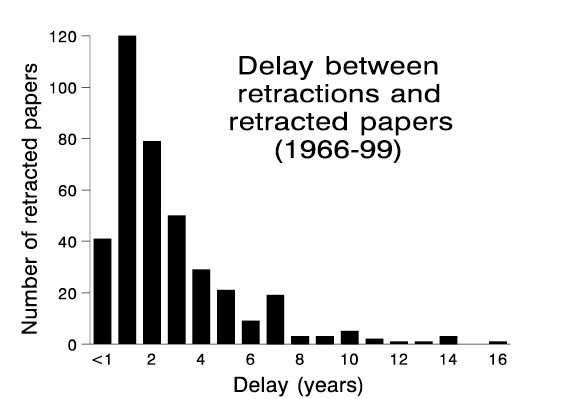December 2000
Retractions 1966-99
Massimo Battaglia
Institute of Neurobiology and Molecular Medicine,
Consiglio Nazionale delle Ricerche, 00133 Rome, Italy
Data on retractions published between 1970 and 1997 have been recently
reported1-3. I now extend these
findings to the period between year 1966 and 1999.
Retractions and retracted papers were searched for in several MEDLINE(r)
databases, including the following freely available on the Internet:
HealthGate Search Page,
Infotrieve Online
, and PubMed.
Cumulative data are shown in Figure 1.
 A total of 387 papers (mean 9.44/year)
were retracted in 321 retraction notices (mean 11.38/year). No retractions were published
until 1977, when 3 appeared, and in 21 years this figure increased up to 43.
This increase was, at least in part, paralleled by a corresponding rise in the total number of
publications. All the retractions except 11 (94.31%) and as many as 365 (94.31%) of the retracted papers
were published in English.
A total of 387 papers (mean 9.44/year)
were retracted in 321 retraction notices (mean 11.38/year). No retractions were published
until 1977, when 3 appeared, and in 21 years this figure increased up to 43.
This increase was, at least in part, paralleled by a corresponding rise in the total number of
publications. All the retractions except 11 (94.31%) and as many as 365 (94.31%) of the retracted papers
were published in English.
As shown in Figure 2, more
than three fifths of the papers were retracted within 2 years, and about three quarters within 3 years after publication.
The mean delay between retracted papers and retractions was 2.65 years, with a range
from less than 1 year to 16 years. This confirms and extends Schiermeier's observations about
the delay in publication of retraction notices4.

It has been previously reported that retracted papers continue to be cited as valid5,
and for this reason a systematic screening, based on the use of appropriate databases, has been
advocated to prevent the citation of fraudulent or retracted papers6.
It is of interest to note that the Office of Research Integrity, that
promotes integrity in biomedical and behavioral research supported by the Public Health Service at about 4,000
institutions worldwide, drew up a new government policy requiring US researchers and other laboratory staff to
undergo training in ethical scientific conduct, that will begin to take effect late next year7.
However, as correctly pointed out by Roy8, the consequences for the research
community derived from fraud or error in papers published in scientific journals are of little importance
as compared to those caused by misconduct in irresponsible or misleading scientific communication to the general public.
Acknowledgment
I am grateful to Francesca Berlinguer for her helpful suggestions and for the checking of English.
-
Hagmann R. Europe stresses prevention rather than cure.
Science 1999; 286: 2258-2259.
-
Correction.
Science 2000; 287: 594.
-
Battaglia M, Lazzara S. 1999;
Retractions 1970-97.
-
Schiermeier Q. Authors slow to retract "fraudulent"
papers. Nature 1998; 393: 402.
-
Budd JM, Sievert ME, Schultz TR. Phenomena of retraction. Reasons for retraction and citations to the publications.
JAMA 1998; 280: 296-297.
-
Campanario JM. Fraud: retracted articles are still being cited.
Nature 2000; 408: 288.
-
Dalton R. NIH cash tied to compulsory training in good behaviour.
Nature 2000; 408: 629.
-
Roy R. Missing the mark on misconduct. Nature 1998; 295 835-836.
 A total of 387 papers (mean 9.44/year)
were retracted in 321 retraction notices (mean 11.38/year). No retractions were published
until 1977, when 3 appeared, and in 21 years this figure increased up to 43.
This increase was, at least in part, paralleled by a corresponding rise in the total number of
publications. All the retractions except 11 (94.31%) and as many as 365 (94.31%) of the retracted papers
were published in English.
A total of 387 papers (mean 9.44/year)
were retracted in 321 retraction notices (mean 11.38/year). No retractions were published
until 1977, when 3 appeared, and in 21 years this figure increased up to 43.
This increase was, at least in part, paralleled by a corresponding rise in the total number of
publications. All the retractions except 11 (94.31%) and as many as 365 (94.31%) of the retracted papers
were published in English.